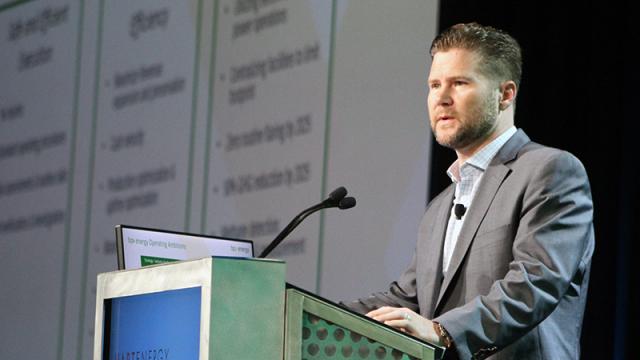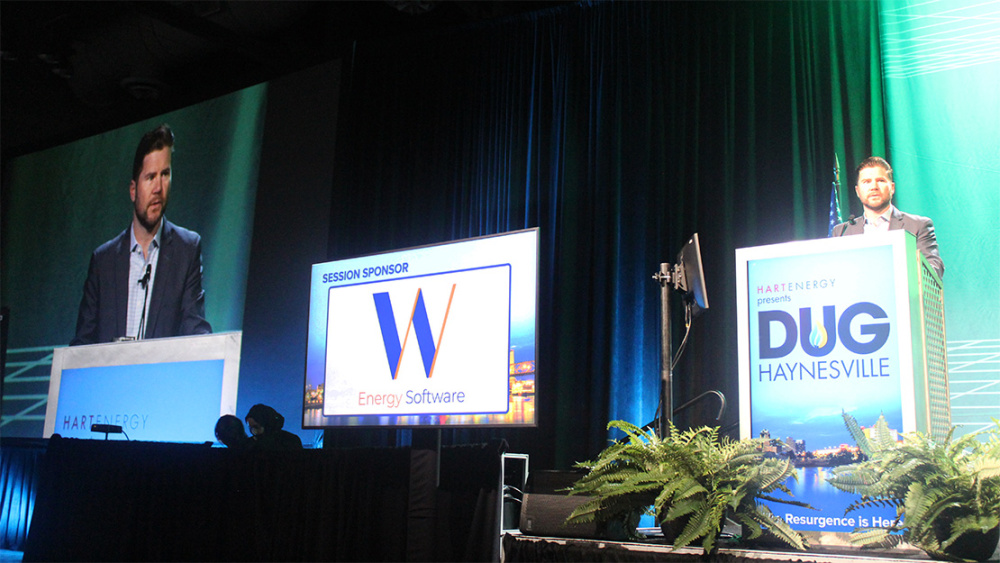
BPX Energy is running three rigs and one frac spread on the Louisiana side of the Haynesville Shale play, said Kyle Koontz, chief development officer for BPX Energy, at Hart Energy’s DUG Haynesville conference and exhibition on May 26. The company has 537,000 net acres in the Haynesville. (Source: Joseph Markman / Hart Energy)
SHREVEPORT, La.—BPX Energy is thinking differently and smarter in the Haynesville, using data and analytics to drive decisions to boost stimulated rock volumes and increase production.
“We’re trying to get out of the old way of thinking—pumping a big frac job and praying it works—and try to get more prescriptive, using more modern technology coupled with analytics that have been prevalent in other industries into how we develop better investments and make smarter decisions,” said Kyle Koontz, chief development officer for BPX Energy.
Speaking to attendees of Hart Energy’s DUG Haynesville conference and exhibition on May 26, Koontz shared how BPX is using digital technology to help guide decisions such as on where to drill the next well, how to complete it and whether to choke back production.
BPX, a wholly owned subsidiary of BP Plc, took over operations in the Haynesville in early 2019 after acquiring the shale assets from BHP as part of a $10.5 billion deal that also included acreage in the Eagle Ford Shale and Permian Basin. The company has 537,000 net acres in the Haynesville, where it is running three rigs and one frac spread on the Louisiana side of the play.
“We haven’t been on it long, but we feel like we’re moving up the learning curve quickly,” Koontz said. “It’s a testament to the team’s commitment to innovation coupled with operational discipline.”
Known for its prolific production of natural gas, seen as a bridge fuel in decarbonization, Haynesville is positioned to play a critical role in the energy transition. Data from the U.S. Energy Information Administration show Haynesville gas production is forecast to rise 239 MMcf/d to 15.1 Bcf/d in June.
Producers like BPX are working to keep the gas flowing.
“If we don’t achieve that first milestone in getting stimulated rock volume, it really doesn’t matter how fast we produce the wells,” Koontz said. “We’re going to be limited in the type of recovery and the types of economics we can get.”
Decisions are typically based on experience and science, he said. But oftentimes, he said, decisions are based on experiences from other plays and that may not always fit situations at hand.

BPX developed a platform that enables its team to make more data-based decisions using raw data inputs that generate information on which the team can act. Blending classical statistics with modern data analytics and traditional oil and gas analysis workflows leads to intelligent, data-driven predictions, he said, adding that in turn leads to new wells with premiere results.
“Each time we work through this workflow, it gets smarter and smarter,” Koontz said.
A series of ID plots were developed to help drive decisions and evaluate investments. Using 2019 as its baseline, he explained how the company aimed to maximize its SRV and boost recovery using the data-driven platform. The company also incorporated rate transient analytics and other analytical tools to improve completions.
“We can use a series in this workflow, the diagnostic tool, to isolate variables and decide which decisions we need to drive improvement, which are more effective, without having to rely on a lot of production history to determine if we’re successful,” Koontz explained. “After we establish our reservoir contact, we have to look at the production strategy.”
The company uses a real-time automated algorithm that calculates productivity downhole as the well is producing. “This runs in the background so that our reservoir engineers and our production engineers can make informed decisions on choke strategy and rate of production,” he said.
Well results indicate how the approach is paying off.
The M&M 39-27 #2 well is BPX’s best well to date with a maximum production rate of 40 MMcf/d.
Other wells highlighted included a pair of super extended laterals at Crestview Woods, located in the northern part of the Louisiana Haynesville play. Drilled to a total depth of 15,000 ft, the wells will come online this summer, he said.
BPX also marked its first Haynesville-Bossier stack with the MUR 21-28-33 No. 1 and No. 2 wells. “We started expanding beyond just the Haynesville looking at all development scenarios in order to understand how these reservoirs are reacting with one another,” Koontz said. “They’re also the first wells where we’ve had site electrification.”
Development comes amid improved natural gas prices. Henry Hub was up 3.68% by noon CT May 25 to $9.30.
Koontz said returns are strong in the Haynesville at today’s prices; however, the company must be profitable without relying only on gas prices.
“We want to make sure that doesn’t slip our mindset into a state of complacency,” he said. “We have to continue to drive innovation and see how good we can become.”

